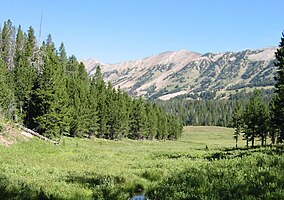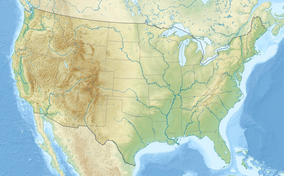Gallatin National Forest
| Gallatin National Forest | |
|---|---|
 | |
| Location | Montana, United States |
| Nearest city | Bozeman, Montana |
| Coordinates | 45°16′21″N 110°22′06″W / 45.27250°N 110.36833°W |
| Area | 2,129,194 acres (8,616.54 km2)[1] |
| Established | February 10, 1899[2] |
| Governing body | U.S. Forest Service |
| Website | Custer-Gallatin National Forest |
The Gallatin National Forest (now known as the Custer-Gallatin National Forest) is a United States National Forest located in South-West Montana. Most of the Custer-Gallatin goes along the state's southern border, with some of it a part of North-West Wyoming.
Geography
The forest area comprises a total of 3,411,239 acres (13,804.79 km2) with around 2,129,194 acres (8,616.54 km2) located in the Gallatin Forest area and 1,282,045 acres (5,188.25 km2) within the Custer. Most of the Gallatin borders Yellowstone National Park and is a part of the Greater Yellowstone Ecosystem, an area which encompasses almost 20,000,000 acres (81,000 km2) in and around the park. The Custer National Forest is spread out along Eastern Montana and the North-West side of Wyoming, with most of its land being held in Montana.[3] The forest stretches through about six counties, including Park, Gallatin, Sweet Grass, Madison, Carbon, and Meagher.
There are six separate
Wilderness Areas
- Absaroka–Beartooth Wilderness (943,626 acres (3,818.72 km2))
- Lee Metcalf Wilderness (254,288 acres (1,029.07 km2)).
Wildlife and vegetation
While the lower elevations are often covered in grasses and
Many species of fish inhabit the numerous rivers and other bodies of water, including
History
The forest is a cross roads and homelands of a number of Indian tribes, and subject to the treaties, cultural traditions and practices of various tribes.[5]
The forest was founded in 1899 as a part of the Northern U.S. Forest Service, eventually being named after Albert Gallatin (1761–1849), a U.S. Secretary of the Treasury and scholar of Native American languages and cultures.
In 1959, a 7.2-magnitude earthquake occurred in Madison Canyon outside of Yellowstone National Park, resulting in a massive landslide that blocked the Madison River and formed what we know as Quake Lake.
As of 2014, the Gallatin National Forest and Custer National Forest were merged administratively in order to combat rising costs, with a new management plan created for both national forests in 2020.[6]
Management
Since 2014, the Gallatin and Custer National Forests are managed together as the Custer–Gallatin National Forest with a headquarters in Bozeman, Montana and an additional office in Billings.[3] There are seven local ranger district offices for the forest, with locations in West Yellowstone, Livingston, Bozeman, Gardiner, Ashland, and Red Lodge for Montana and Camp Crook for South Dakota.
Access
There's access to the forest off Interstate 90 South on U.S. Highway 89 from Livingston, Montana, to Gardiner, Montana, or South on U.S. 191 from Bozeman, Montana, to West Yellowstone.
Over 2,290 mi (3,690 km) of
-
Daisy Pass near Cooke City, Montana
-
A view of Gallatin National Forest in 1921
-
A photograph taken of the Forest in 1962
-
Yellowstone National Park, seen from Gallatin
-
The remains of a building damaged by the1959 Yellowstone earthquake
See also
- List of U.S. National Forests
- List of forests in Montana
References
- ^ "Land Areas of the National Forest System" (PDF). U.S. Forest Service. October 2021. Retrieved May 24, 2022.
- ^ "The National Forests of the United States" (PDF). U.S. Forest Service. Archived from the original (PDF) on October 28, 2012. Retrieved June 25, 2012.
- ^ a b c "Land Areas of the National Forest System" (PDF). U.S. Forest Service. January 25, 2021. Retrieved May 24, 2022.
- OCLC 34618216.
- ^ Bergstrom, Mike (February 16, 2017). Assessment, Forest Plan Revision, Final Areas of Tribal Importance Report (PDF) (Report). Custer Gallatin National Forest.
- ^ Lundquist, Laura (November 14, 2014). "Custer and Gallatin forests finalize merger". Bozeman Daily Chronicle. Retrieved May 24, 2022.







